 W
WA baldric is a belt worn over one shoulder that is typically used to carry a weapon or other implement such as a bugle or drum. The word may also refer to any belt in general, but this usage is poetic or archaic. In modern contexts, military drum majors usually wear a baldric.
 W
WA buccina or bucina, anglicized buccin or bucine, is a brass instrument that was used in the ancient Roman army, similar to the cornu. An aeneator who blew a buccina was called a "buccinator" or "bucinator".
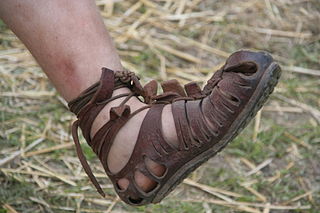 W
WCaligae are heavy-soled hobnailed military sandal-boots worn as standard issue by Roman legionary foot-soldiers and auxiliaries, including cavalry.
 W
WA cingulum militare was a piece of ancient Roman military equipment in the form of a belt decorated with metal fittings, which was worn as a badge of rank by soldiers and officials. Many examples were made in the Roman province of Pannonia.
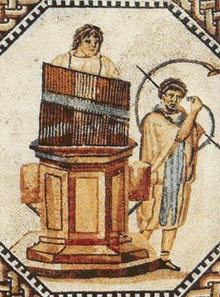 W
WA cornu or cornum was an ancient Roman brass instrument about 3 m (9.8 ft) long in the shape of a letter 'G'. The instrument was braced by a crossbar that stiffened the structure and provided a means of supporting its weight on the player's shoulder. Some specimens survive in the archaeological record, two from the ruins of Pompeii.
 W
WThe dolabra is a versatile axe used by the people of Italy since ancient times. The dolabra could serve as a pickaxe used by miners and excavators, a priest's implement for ritual religious slaughtering of animals and as an entrenching tool (mattock) used in Roman infantry tactics.
 W
WThe focale, also known as a sudarium, was a woolen or linen scarf worn by ancient Roman military personnel. It protected the neck from chafing by the armor. The focale is depicted widely in military scenes from Roman art, such as the relief sculpture on the Arch of Septimius Severus in the Roman Forum and Trajan's Column. It is shown loosely knotted in the front, but is sometimes visible with the ends tucked inside the cuirass.
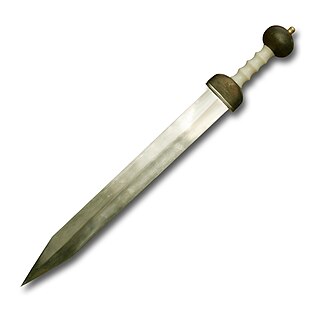 W
WGladius is a Latin word meaning "sword", but in its narrow sense, it refers to the sword of Ancient Roman foot soldiers. Early ancient Roman swords were similar to those of the Greeks, called xiphe. From the 3rd century BC, however, the Romans adopted a sword based on the weapons used by the Celtiberians in Hispania late into the Punic Wars, known in Latin as the gladius hispaniensis, or "Hispanic sword".
 W
WA greave or jambeau is a piece of armour that protects the leg.
 W
WA galea was a Roman soldier's helmet. Some gladiators, specifically myrmillones, also wore bronze galeae with face masks and decorations, often a fish on its crest. The exact form or design of the helmet varied significantly over time, between differing unit types, and also between individual examples – pre-industrial production was by hand – so it is not certain to what degree there was any standardization even under the Roman Empire.
 W
WA javelin is a light spear designed primarily to be thrown, historically as a ranged weapon, but today predominantly for sport. The javelin is almost always thrown by hand, unlike the sling, bow, and crossbow, which launch projectiles with the aid of a hand-held mechanism. However, devices do exist to assist the javelin thrower in achieving greater distance, generally called spear-throwers.
 W
WLoculus is a Latin word literally meaning little place and was used in a number of senses including to indicate a satchel. Satchels were carried by Roman soldiers as a part of their sarcina or luggage.
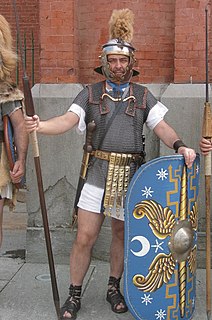 W
WThe lorica hamata is a type of mail armour used by soldiers for over 600 years from the Roman Republic to the Roman Empire. Lorica hamata comes from the Latin hamatus (hooked) from hamus which means "hook", as the rings hook into one another.
 W
WThe lorica plumata also known the lorica hamata squamatque was a set of Roman armor. The name Lorica Plumata translates to feathered cuirass. The reason the armor has this armor had this name, is because it had a feathered appearance due to the feather-like scales called plumes attached to oval shaped rings. The Lorica Plumata was a sleeveless armor with no shoulder guards that looked like a Linothorax. It was possibly reserved exclusively for the use of military leaders of the rank of Tribune or above. Although typically only generals wore it due to the high cost of production, and maintenance. The Lorica plumata would have been an expensive piece of military equipment. The Lorica plumata was one of the few sets of armor that combined mail and scales.
 W
WThe lorica segmentata, also called lorica lamminata, is a type of personal armour that was used by soldiers of the Roman Empire, consisting of metal strips fashioned into circular bands, fastened to internal leather straps. The lorica segmentata has come to be viewed as iconic of the Roman legions in popular culture. The tendency to portray Roman legionaries clad in this type of armour often extends to periods of time that are too early or too late in history.
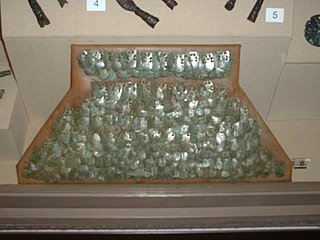 W
WThe lorica squamata is a type of scale armour used by the ancient Roman military during the Roman Republic and at later periods. It was made from small metal scales sewn to a fabric backing. No examples of an entire lorica squamata have been found, but there have been several archaeological finds of fragments of such shirts and individual scales are quite common finds—even in non-military contexts.
 W
WThe Mainz Gladius or Sword of Tiberius is a famous ancient Roman sword and sheath that was found in the Rhine near Mainz in Germany. Since 1866 it has been part of the British Museum's collection, when it was given to the museum by the philanthropist Felix Slade. A replica of the Mainz Gladius can be found in the Romano-Germanic Central Museum (Mainz). The type of gladius was first introduced to the Romans in 20 BC. Eventually the Mainz Gladius was overtaken in popularity by the Pompeii Gladius.
 W
WA manica was a type of iron or bronze arm guard, with curved and overlapping metal segments or plates, fastened to leather straps, worn by Roman gladiators called crupellarii, and later optionally by soldiers.
 W
WPteruges refers to strip-like defences for the upper parts of limbs attached to armor in the Greco-Roman world.
 W
WThe pugio was a dagger used by Roman soldiers as a sidearm. It seems likely that the pugio was intended as an auxiliary weapon, but its exact purpose for the soldier remains unknown. Officials of the empire took to wearing ornate daggers in the performance of their offices, and some would wear concealed daggers for defense in contingencies. The dagger was a common weapon of assassination and suicide; for example, the conspirators who stabbed Julius Caesar used pugiones. The pugio developed from the daggers used by the Cantabarians of the Iberian peninsula.
 W
WThe sarcina was the marching pack carried by Roman legionaries, the heavy infantry of the Roman legions.
 W
WThe scutum was a type of shield used among Italic peoples in antiquity, and then by the army of ancient Rome starting about the fourth century BC.
 W
WThe sudis was a stake carried by Roman legionaries for employment as a field fortification, sometimes also called vallus. It is frequently, but incorrectly, called a pilum murale. Typically, two such stakes were carried by each soldier.
 W
WA tunic is a garment for the body, usually simple in style, reaching from the shoulders to a length somewhere between the hips and the knees. The name derives from the Latin tunica, the basic garment worn by both men and women in Ancient Rome, which in turn was based on earlier Greek garments that covered wearers' waists.